
l to r: Phono 1, Phono 2, Aux, Tuner, Tape in/out (RCA), Tape in/out (DIN)
|
http://www.ozvalveamps.org/repairs/ta1010.html | Created: 24/12/10 | Last update:
16:09 5/01/11
<<< OzValveAmps |
More useful inputs.
New: 24/12/10

I still have a soft spot for the domestic stereo amps from the end of the LP disc turntable era.
These can be recognised by having a pair of RCA connectors on the back for “phono”, and nearby an earthing terminal (“Ground” at left, above).
One of the best were the Sansui blackface series, but in black, silver or gold, the fashion colour for that year, most of this style of stereo amp were well built and designed, and practical to repair.
As amplifiers they are nothing remarkable, normally clean, wide enough, and capable of up to 50 watts of programme (i.e. peak and not sustained power) and their usefulness is proportional to how many inputs and outputs they have (above), and their provision for signal switching.
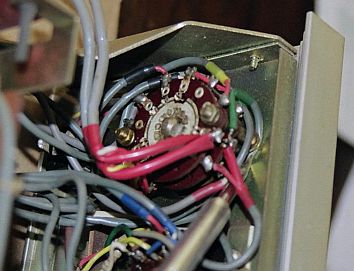
Source selector switch
This is one of the current house sound systems at AVA, yet another item of cast off junk. These can still fetch around $50-$200 in good condition, but most of them aren't, and like this one can be picked up begging for a home.
As always it's the switch contacts and pots that get noisy and intermittant, so giving all the controls a good wash with metho can cure a lot of ills.
But this particular one had a deeper problem with one channel very weak.
And like all amps of this era it has a phono input. This is designed to accept a signal from a magnetic turntable pickup, and this input (or two in the case of this particular amp) are equalised to the RIAA response curve.
Phono inputs have an RIAA Equalisation profile.
A magnetic pickup is velocity sensitive, so that when its stylus traces a high frequency on the disc it moves more rapidly and generates more signal voltage.
This means that it has a “rising characteristic”, the amount of signal produced rises in direct proportion to frequency. If reproduced like this it would sound very thin and shrill without any bass.
Amplifiers were therefore equipped with specific “Phono” inputs that have a preamp with exactly the opposite, or conjugate, falling characteristic, the end result being flat reproduction with all frequencies being correctly represented, the bass boosted and the treble muted. These are incidentally very sensitive at around only 10mV @1kHz for full output
This also means that they aren't any use for anything else, and given the number of sources we can have in the modern home entertainment setup it is also quite short of Aux or Line level inputs.
Line level
There is a defined line level, 0dBm = 1mW in 600 ohms;
Rule: P = E^2/R Transpose: E = sqroot(P/R) So; (0.001*600)^0.5=0.77459667 volt 775mVrms, 1.1VpkThe actual input impedance of an Aux or Line in on these amps may be anywhere between 10k and 100k, but 47k is by far the most common.
During cleaning a badly burnt resistor was spotted in the middle of the preamp board.
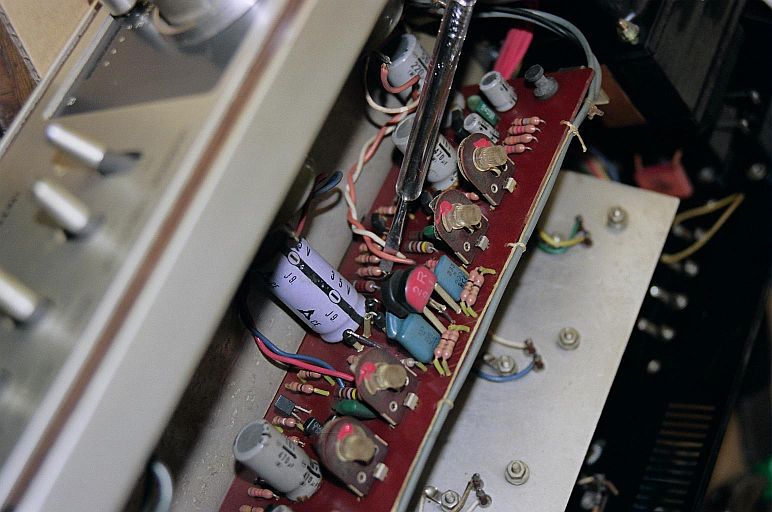
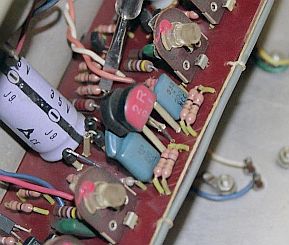
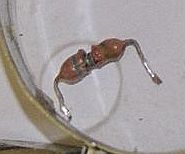
This turned out to be in the power feed to one of the preamps and to have some residual resistance allowing some weak amplification.
The key question is always “why?”, but in this case there was no sign at all of what may have caused such a drastic short in the preamp area, but given it is decades old and history quite unknown, it remains a mystery. This is very unsatisfactory in repair terms because you always want to know what the basic cause of a fault before you can be certain it really is repaired.
This is actually a very simple mod but adding two new Aux inputs it has made a big difference to the home sound system.
Originally this amp would have been connected to a turntable, cassette deck, and AM/FM radio tuner, and the Aux input would have been spare.
The flat Aux or Line-in is the reference input, typically being the main amp input level via the volume control.
The Tuner input is generally like the flat Aux input, but may include a Low Pass Filter to cut off any 10kHz interstation hetrodyne from AM signals.
The Tape connections for the cassette (or reel-to-reel) consist of Line level inputs for playback and outputs for recording. In this amp they are also available in two forms, RCA and DIN. Australia follows American practice and almost universally use RCA connections, but the European DIN connector is often available as a quick and foolproof alternative way to connect a cassette deck and an amp without crossing Left and Right or Record and Replay.
These inputs go back to the selector switching on the amp, and this varies considerably between amps. Some form of input source selector is common, as is an ability to monitor the send or return from the recording device. Another amp I have also has a recording out selector, and facilities for two cassette decks but this is less common. This amp has been particularly useful with the computer soundcard as “cassette two”.
But times and equipment line-ups change and these days I need to patch the sound from various TV/Video systems into the stereo, and with a cassette deck, VCR, DVD, CD, and STB, and there just aren't enough inputs. Yet we have two Phono inputs we don't and can't use.
There are a few ways of converting a Phono input to a flat Line level input, wiring the Phone preamp out, or using an anti-RIAA network ahead of the input (which I will come back to below).
In many of these amps the phono preamp is actually a seperate module and can be located by a bit of cable tracing from the Phono input sockets.
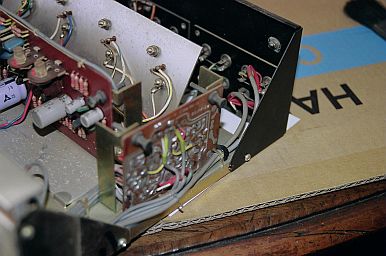
In this case the two sets of inputs first went across to the source selector switch, then the selected stereo pair back to the RIAA preamp inputs. The outputs then go back to the selector where they are treated the same as the Aux input.
In this case the signal flow was pretty obvious, in to the top and out of the bottom of the RIAA preamp PCB.
It was an easy matter to lift the co-ax leads off the PCB and connect them together, bypassing the RIAA preamp altogether.
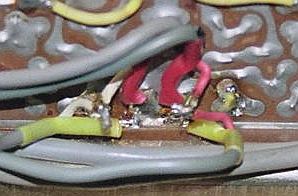
An alternative to going inside the amplifier is to use a filter network in series with the input which has the opposite characteristic to the RIAA, a Reverse-RIAA network.

The 75k can be made up of 2x 150k in parallel
Despite being quite lossy, this filter works because the Phono input is quite sensitive, but this does mean that care needs to be taken to screen the assembly in some form of grounded container.
The response curve shows how the filter shapes a flat input so that it has the same shape as a magnetic pickup, which the RIAA preamp will return to flat.
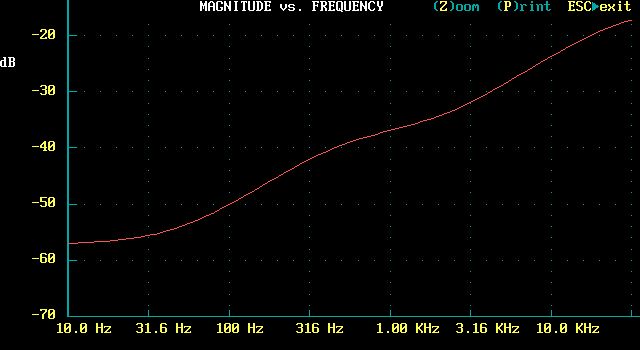
|
|